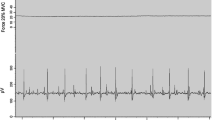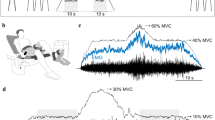Summary
Although recruitment in man often proceeds from the slowest to fastest motor units, a variety of stimuli can alter this order. To study the effect of recruitment order on isometric performance, the tetanic tension of individual fast and slow twitch motor units was measured during fatiguing isometric contractions of the medial gastrocnemius muscle of the cat with recruitment proceeding from either the slowest to fastest or fastest to slowest motor units throughout the contractions. The muscles were stimulated electrically through the ventral roots of the spinal cord. Fatiguing isometric tensions were examined at 10, 20, 40, 70, or 100% of the initial strength of the muscles at 28 and 38‡ C. The results of these experiments showed that for contractions at low isometric tensions (20 and 40% of the muscles' strength), especially at the lower temperature, the endurance was longer when recruitment proceeded from the slowest to fastest units. The reason for this appeared to be linked to the more rapid rate of fall of tension over time in fast as opposed to slow twitch motor units.
Similar content being viewed by others
References
Ariano M, Armstrong RB, Edgerton VR (1973) Hindlimb muscle fiber populations in five animals. J Histochem Cytochem 21: 51–55
Barcroft H, Edholm OG (1946) Temperature and blood flow in the human forearm. J Physiol (Lond) 104: 366–376
Bigland B, Lippold OC (1954) Relationship between force, velocity and integrated electrical activity in human muscles. J Physiol (Lond) 123: 214–224
Buller AJ, Ranatunga KW, Smith JM (1968) The influence of temperature on the contractile characteristics of mammalian fast and slow twitch skeletal muscles. J Physiol (Lond) 196: 82
Burke RE, Levine DN, Zajac III FE, Tsairis P, Engel WK (1979) Mammalian motor units: Physiological-histochemical correlation in three types in cat gastrocnemius. Science 174: 709–712
Close RI (1972) Dynamic properties of mammalian skeletal muscles. Physiol Rev 52: 192–197
Close R, Hoh JFY (1968) Influence of temperature on isometric contractions of rat skeletal muscles. Nature 217: 1179–1180
Folkov B, Hudlicka A (1968) A comparison between red and white muscle with respect to blood supply, capillary surface area, and oxygen uptake during rest and exercise. Microvasc Res 1: 1–16
Grimby L, Hannerz J (1976) Disturbances in voluntary recruitment order of low and high frequency motor units on blockades of proprioceptive afferent activity. Acta Physiol Scand 96: 207–216
Hannerz J, Grimby L (1979) The afferent influence on the voluntary firing range of individual motor units in man. Muscle and Nerve 2: 414–422
Milner-Brown HS, Stein RB (1975) The relations between the surface electromyogram and muscular force. J Physiol (Lond) 246: 549–569
Olson CD, Carpenter DO, Henneman E (1968) Orderly recruitment of muscle action potentials. Arch Neurol 19: 591–597
Petrofsky JS (1978) Control of the recruitment and firing frequency in electrically stimulated muscle in the cat. Med Biol Eng Comput 16: 302–308
Petrofsky JS, Lind AR (1975a) Insulative power of body fat on deep muscle temperature and isometric endurance. J Appl Physiol 39: 639–642
Petrofsky JS, Lind AR (1975b) The relationship of body fat content to deep muscle temperature and isometric endurance in man. Clin Sci Mol Med 48: 405–412
Petrofsky JS, Lind AR (1979) Isometric endurance in fast and slow muscles in the cat. Am J Physiol 236: C185-C191
Petrofsky JS, Phillips CA (1979) Determination of the contractile characteristics of the motor units in skeletal muscle through twitch characteristics. Med Biol Eng Comput 17: 525–533
Petrofsky JS, Lind AR (1980) The effect of temperature on the isometric properties of cat skeletal muscle. Eur J Physiol (in press)
Ranatunga VW (1977) Influence of temperature on the characteristics of summation of isometric mechanical responses of mammalian skeletal muscle. Exp Neurol 54: 513–532
Thomas JS, Schmidt ES, Hambrecht FT (1978) Facility of motor unit control during tasks defined directly in terms of unit behavior. Exp Neurol 59: 384–395
Author information
Authors and Affiliations
Additional information
Supported by the NIH grant number 7ROINS16003-01
Rights and permissions
About this article
Cite this article
Petrofsky, J.S. The influence of recruitment order and temperature on muscle contraction with special reference to motor unit fatigue. Europ. J. Appl. Physiol. 47, 17–25 (1981). https://doi.org/10.1007/BF00422479
Accepted:
Issue Date:
DOI: https://doi.org/10.1007/BF00422479




